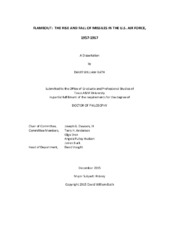| dc.description.abstract | This dissertation documents how the U.S. national perspective toward ballistic nuclear missiles changed dramatically between 1957 and 1967 and how the actions and attitudes of this time brought about long term difficulties for the nation, the Air Force, and the missile community. In 1957, national leaders believed that ballistic missiles would replace the manned bomber and be used to win an anticipated third world war between communist and capitalist nations. Only ten years later, the United States was deep into a limited war in Vietnam and had all but proscribed the use of nuclear missiles. This dissertation uses oral histories, memoirs, service school theses, and formerly classified government documents and histories to determine how and why the nation changed its outlook on nuclear ballistic missiles so quickly. The dissertation contends that because scientists and engineers created the revolutionary weapon at the beginning of the Cold War, when the U.S. and U.S.S.R. were struggling for influence and power, many national leaders urged the military to design and build nuclear ballistic missiles before the Soviet Union could do so. This pressure prompted the Army, the Navy, and the Air Force to compete for the new mission and wasted billions of dollars as the services built duplicative, unreliable and unsafe liquid fueled missiles that were only in use for a few years. Then, as the Cuban Missile Crisis revealed the true threat of nuclear conflict, the perspective towards nuclear missiles changed considerably.
The dissertation also argues that the Air Force garnered control of the new capability, primarily to retain and protect their manned strategic air mission, so it chose not to deal with inherent problems of missile duty that were revealed almost immediately, such as loneliness, boredom, tedium, and an inability to find a sense of accomplishment. Once U.S. political leaders turned their focus away from nuclear war and toward the Vietnam conflict, the Air Force relegated the missileers -- those selected to operate the new missiles -- to secondary status, allowing their concerns to fester for decades. Missileers created a proud, but dysfunctional organization that rewarded what Secretary of the Air Force Deborah Lee James in 2014 called unrealistic test scores rather than operational experience and expertise. At the same time, the Air Force intensified an unhealthy focus on manned flight that prevented the service from most effectively incorporating and using advances in technology to defend the nation. | en |


